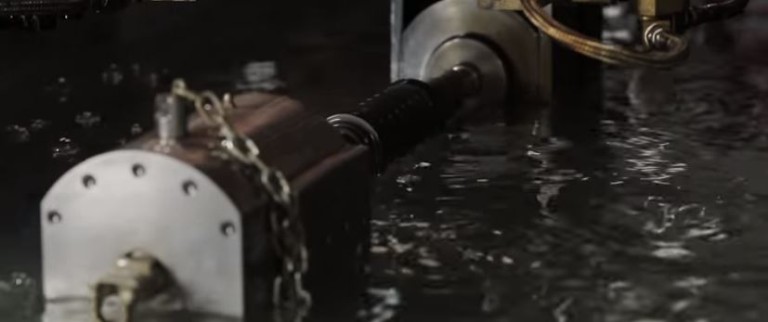It’s Not Just the Heat, it’s the Cool.

We say that around here to remind us and our customers that the terms “heat treating” and “flame hardening” only tell half the story. Heating metal seems to hog all the glamor, but cooling metals correctly literally makes or breaks the part. As we’ve said before on this blog, do not underestimate what happens when hot steel gets put into or under a quench solution. The speed of the heat transference during cooling determines the final structure of the steel. So when we design a quench system for our flame hardening equipment, we pay attention to three important factors:
1. Pace – how quickly the quench solution cools the material being used
2. Application – whether it’s best to dunk the part into a quench tank or spray it from a flame head
3. Temperature – how to keep the quench solution at just the right temperature for the material
4. Agitation – how to keep the quench moving so that the resulting hardness is evenly distributed
I’ll address the first factor here, and the other three in the next blog. Yes, it’s that complicated: people make entire careers out of quenching applications to improve transference and strengthening. I’m only writing these blogs out of my own experience in the industry, and passing it along so you might benefit and avoid some common pitfalls.
One problem is that you can’t see the heat transference when it’s happening, so it’s hard to monitor and detect. That can cause people to misunderstand or underestimate the importance of quenching to the entire heat treating process. Heat transference occurs very quickly – so it can be mismanaged easily, resulting in parts that can fail or at least fail to meet spec. So we work hard to build highly controlled quench processes in our flame hardening equipment. Sometimes our customers find it hard to see value in that. They want to run water from their facility pipes into a tank or through a spray, and we have to explain why that probably won’t get them the results they need. I’ll try to explain that here.
The actual transformation of the steel to martensite occurs during the heat cycle, but the quench makes the transformation permanent. Without the proper quench cycle, the new structure of the steel will not solidify properly. The first factor we look at to determine the proper quench cycle is quench severity. Severity means the rate of cooling achieved by particular quenches. The following list shows different quench solutions and their relative cooling speeds, starting from the most severe quench (fastest cool) to the least severe (slowest cool):
1. Brine (salt water) – fastest cool
2. Straight water
3. Various solutions of synthetic quench
4. Oil
5. Air – slowest cool
For example, a straight carbon steel (1045) needs a relatively fast quench, like straight water. Depending on the geometry of the part (thickness primarily) your quench will need to match its heating properties. Imagine that you have a thin strip 16” of steel and you heat it up: because it lacks much mass, the part heats really fast. So also will it cool just as fast – meaning you may need to design a quench system that slows down the process, so the part won’t shatter. But a big ingot of 500 lb piece of steel takes a lot time to heat up to austenizing temperature. It will therefore also take a while to cool down as well – so you may need to design a quench system that speeds up the process so you don’t lose the correct structure. The larger the mass, then, the more severe quench you can use without danger of damage to the part. The smaller the mass, the slower the quench solution needs to be.
In conclusion, an important part of engineering heat treating solutions in general and flame hardening solutions in particular, is matching the quench with the material and geometry of the hardened parts. So, the geometry and the material of your part determines the type of quench solution and the type of application it needs. Many people think heat treating is just about the heat, but it’s also the cool. Your parts need an appropriate application of quench, and the appropriate quench solution itself at the right temperature, to succeed in the field. Cutting corners on this part of the flame hardening equipment often means constant headaches dealing with returns and failures and inconsistent hardening levels. We can’t stress it enough: flame hardening is also cool!
Call 919-956-5208 or email me (mark@flametreatingsystems.com) with any questions you have about your quench processes, and whether it could be a solution to quality issues you’re experiencing.
B24: We would like to know your opinion.






